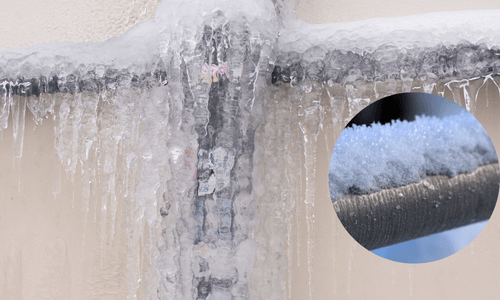
How to Unfreeze Water Pipes: Safe and Fast Solutions
Frozen water pipes can be a nightmare for homeowners, causing inconvenience, potential water damage, and even burst pipes. Knowing how to safely and effectively thaw frozen pipes is essential for maintaining the integrity of your plumbing system, especially during colder months. In this comprehensive guide, experts at Local Plumber will provide quick tips and techniques for unfreezing water pipes safely and quickly. From identifying frozen pipes to implementing thawing methods, we’ve got you covered.Identifying Frozen Pipes:
Identifying frozen pipes is crucial for homeowners, especially during colder months when the risk of freezing is higher. Recognizing the signs of frozen pipes allows for prompt action to prevent potential water damage and burst pipes. Here’s a detailed explanation of how to identify frozen pipes:No Water Flow:
One of the most common signs of frozen pipes is a lack of water flow from faucets or fixtures. If you turn on a faucet and only a trickle or no water comes out at all, it’s likely that the pipe supplying that fixture is frozen. Check multiple faucets throughout your home to determine if the issue is isolated to a specific area.Visible Frost:
Inspect exposed pipes, especially those in unheated areas such as basements, crawl spaces, or attics, for signs of frost or condensation. Frost on the exterior of pipes indicates that the water inside has frozen. Look for frost patterns or ice buildup along the length of the pipe, particularly near joints or bends where freezing is more likely to occur.Strange Smells:
In some cases, frozen pipes can cause strange odors to emanate from faucets or drains. This odor may be a result of trapped air or gases in the pipe due to freezing. If you notice unusual smells coming from your plumbing fixtures, especially during cold weather, it could be a sign of frozen pipes.Visible Bulging or Swelling:
In severe cases of frozen pipes, the ice inside the pipe can cause it to bulge or swell outward. Inspect visible pipes for any signs of distortion, especially in areas where the pipe is exposed or easily accessible. Bulging pipes are a clear indication that freezing has occurred and may lead to burst pipes if not addressed promptly.By being vigilant for these signs of frozen pipes, homeowners can take proactive measures to thaw the pipes and prevent further damage to their plumbing system. If you suspect that your pipes are frozen, it’s essential to act quickly to minimize the risk of burst pipes and water damage to your home.
Safety Precautions:
When dealing with frozen pipes, safety should always be the top priority. Taking appropriate precautions can help prevent accidents, injuries, and property damage. Here are essential safety precautions to follow when addressing frozen pipes:Turn Off Water Supply:
Before attempting to thaw frozen pipes, shut off the main water supply to your home. This step prevents additional water from entering the pipes and reduces the risk of flooding in case a pipe bursts during thawing.Open Faucets:
Open faucets connected to the frozen pipes to relieve pressure and allow water to flow once thawed. This prevents pressure buildup inside the pipes, reducing the likelihood of bursts.Avoid Open Flames:
Never use open flames or high-heat devices, such as blowtorches or propane heaters, to thaw frozen pipes. These methods can damage pipes, pose fire hazards, and increase the risk of carbon monoxide poisoning. Instead, opt for safer thawing methods that use controlled heat sources.Use Safe Heating Sources:
When thawing frozen pipes, use safe heating sources such as hairdryers, heat lamps, electric heating pads, or heating blankets. These tools provide controlled heat and reduce the risk of accidental fires or injuries. Keep a safe distance between the heating source and any flammable materials to prevent accidents.Monitor Electrical Appliances:
If using electrical heating devices, such as hairdryers or heating pads, ensure they are in good working condition and avoid using them near water. Monitor the appliances closely during use to prevent overheating or electrical malfunctions.Ventilation:
Ensure proper ventilation in the area where you’re thawing the pipes to prevent the accumulation of fumes or gases. Open windows or doors and use fans to improve air circulation and reduce the risk of carbon monoxide buildup.Protective Gear:
Wear appropriate protective gear, such as gloves and safety goggles, when handling heating devices or working in cramped spaces. This protects you from burns, cuts, or other injuries that may occur during the thawing process.Seek Professional Help:
If you’re unsure about how to safely thaw frozen pipes or encounter any complications, don’t hesitate to seek professional help from a licensed plumber. Professionals have the expertise and specialized equipment to safely address frozen pipes and prevent further damage to your plumbing system.By following these safety precautions, homeowners can effectively thaw frozen pipes while minimizing the risk of accidents, injuries, and property damage. Prioritizing safety ensures a smooth and successful thawing process, allowing you to restore water flow to your home without compromising your well-being.
Thawing Methods:
When faced with frozen pipes, employing the right thawing methods is essential to safely and effectively restore water flow and prevent damage to your plumbing system. Here are several thawing methods along with detailed explanations of each:Hairdryer or Heat Lamp:
Using a hairdryer or heat lamp is a common and effective method for thawing frozen pipes. Hold the hairdryer or heat lamp close to the frozen section of the pipe and move it back and forth along the length of the pipe. Start from the faucet end and work towards the frozen section, applying heat evenly until water begins to flow.Hot Towels or Rags:
Soaking towels or rags in hot water and wrapping them around the frozen pipe is another effective thawing method. The hot towels transfer heat to the pipe, helping to thaw the ice inside. Replace the towels as they cool down and continue until the pipe thaws completely.Electric Pipe Heating Tape:
Electric pipe heating tape is designed specifically for thawing frozen pipes. Wrap the tape around the frozen section of the pipe according to the manufacturer’s instructions. Plug in the heating tape and wait for it to gradually thaw the pipe. Monitor the process closely to ensure safe and effective thawing.Space Heater:
Placing a space heater near the frozen pipe can help thaw the ice inside. Position the heater at a safe distance from the pipe, ensuring proper ventilation and avoiding contact with flammable materials. Monitor the area closely to prevent overheating and fire hazards.Warm Water Soak:
If accessible, submerging the frozen pipe in warm water can help expedite the thawing process. Fill a basin or container with warm water and immerse the affected section of the pipe. Replace the water periodically to maintain warmth and continue until the pipe thaws completely.Commercial Thawing Products:
There are various commercial thawing products available, such as thawing sprays or gels, that can be effective for thawing frozen pipes. Follow the manufacturer’s instructions carefully when using these products and ensure they are suitable for use on plumbing pipes.When choosing a thawing method, consider factors such as accessibility, safety, and the severity of the freeze. It’s essential to exercise caution and avoid using open flames or high-heat devices, as they can damage pipes or pose fire hazards. If you’re unsure about which method to use or encounter any complications, it’s best to seek professional help from a licensed plumber.
After Thawing:
- Inspect for Damage: Once the pipe is thawed, inspect it for any signs of damage, such as cracks or leaks.
- Slowly Restore Water: Gradually turn on the main water supply and faucets to allow water to flow slowly and check for leaks.
- Prevent Freezing in the Future: Take preventive measures to prevent pipes from freezing again, such as insulating exposed pipes, sealing drafts, and maintaining a consistent indoor temperature.
By following these safe and effective thawing methods provided by experts at Local Plumber, Florida residents can tackle frozen pipes with confidence and protect their plumbing system from damage.
Remember to prioritize safety, use appropriate thawing techniques, and take preventive measures to minimize the risk of frozen pipes in the future. If you encounter stubborn frozen pipes or experience any plumbing issues, don’t hesitate to contact a professional plumber for assistance. With the right knowledge and precautions, you can keep your plumbing system flowing smoothly even in the coldest weather.
Contact us today for any plumbing issues and we shall be at your service. Email us at services@local-plumber.com or call us at 813-776-7667 (POOP).





Leave a comment